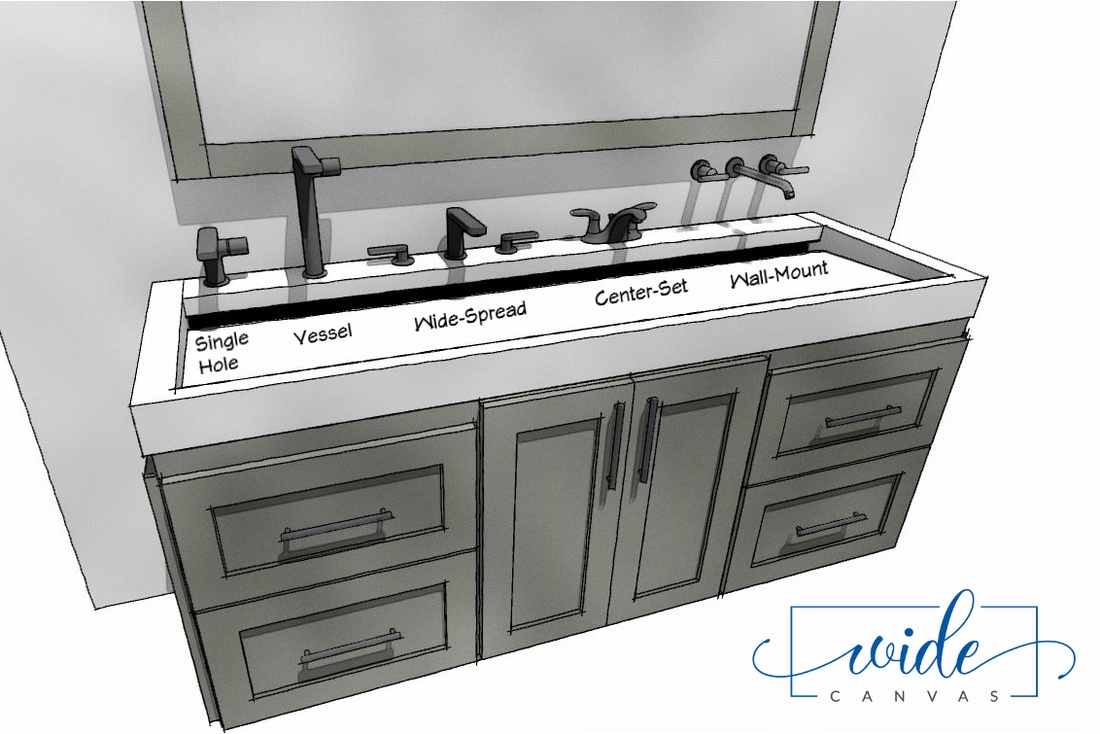
Designing Your New Vanity, Part IV - Choosing Your Sink & Faucet
Share

Photo by Austin Jackson
Previous blog posts in this series covered steps I, II, and III of designing your bathroom vanity: deciding how your new room will feel, planning the space, and choosing between an off-the-shelf and custom vanity.
Now, let's talk about the fixtures you will put in your new vanity: the sink and faucet.
Sinks and faucets are classified by the way they're "mounted," or installed. In this blog post, I'll explain the different types and give you the pros and cons of each.
Your Vanity Sink Options
Undermount or Drop-In
An undermount sink sits below your countertop, and a drop-in sink overlaps your countertop.
Here's a vanity with an undermount sink:
And, here's a vanity with a drop-in sink:
Drop-in sinks have fallen out of favor with my private interior design clients. I can't remember the last time I designed a bathroom using one. Why? Clients don't like the way dirt and grime accumulate where the edge of the sink meets the countertop. Drop-in sinks remind them of old, cruddy bathrooms.
Undermount sinks have no such seam since they are mounted to the bottom of the countertop. You can wipe that dirt and grime right to the edge of the countertop and into the sink. Easy. Clean.
The countertop you use with an undermount sink needs to be impervious to water. That usually means sealed natural stone or quartz; no laminates.
Drop-in sinks have a clear advantage when it comes to repairs and replacement. The overlapping lip gives you some wiggle room on the size and shape of the new sink. An undermount sink must be replaced with one of the same size and shape. You could try to find a countertop fabricator to alter the existing undermount sink cut out, but that's not going to be easy.
Vessel or Bowl
Sits on top of your countertop. The design and shape of the sink are on show here. Use a shorter vanity so that the top of the sink is about 36 inches off the floor, and recognize that your countertop will be a lower than average. The typical countertop is 36 inches above the floor, while a countertop under a vessel sink is about 30 inches above the floor. Use any countertop material with a vessel sink.
Here's a vanity with a vessel sink:
Sink Tops, including Trough Sinks
The perfect marriage of a sink and a countertop; the sink is the countertop. As with a vessel sink, you'll need to shorten your vanity.
The trick here is sizing the vanity to fit the sink top. Check the manufacturer's specifications and follow them precisely.
Here's a vanity with a sink top. Note the shorter vanity with only two drawers per side. In this case, it's a trough sink.
Wall-Mount, Pedestal, and Console Sinks
I didn't want to leave out these three sink types that don't require a cabinet or a countertop. You can save some money and fit a sink in a small space by installing a wall-mount, pedestal, or console sink. The downside, little or no storage. Some console sinks include an open shelf, but that's it.
A wall-mount sink:
A pedestal sink:
And, a console sink:
Your Faucet Options
Deck Mount
Includes all faucets that sit on the sink or countertop, a.k.a. the deck: single-hole, vessel, wide-spread, and center-set.
Single-hole faucets are the most popular with my interior design clients. They take up less countertop space, are easier to clean around, and look up-to-date. They're less expensive too.
The vessel faucet is a tall single-hole faucet. It's designed to reach above the lip of a vessel sink and pour into the bowl.
Wide-spread faucets lend themselves to more traditional designs, especially master bathrooms, where you want to make a statement.
My clients never ask for center-set faucets. When they look at them, they see "out-of-date" and "cheap."
Wall Mount
Increasingly popular, wall-mount faucets free up counter space and look striking. Choose one when you want to make a statement and highlight the faucet itself.
Here, side by side, are the five types of faucets:

This blog post is part of a series.
Designing Your New Vanity, Part I - Feel
Designing Your New Vanity, Part II - Space Planning
Designing Your New Vanity, Part III - Off-the-Shelf or Custom?
You're reading: Designing Your New Vanity, Part IV - Choosing Your Sink & Faucet
Designing Your New Vanity, Part V - Choosing Your Countertop & Backsplash










